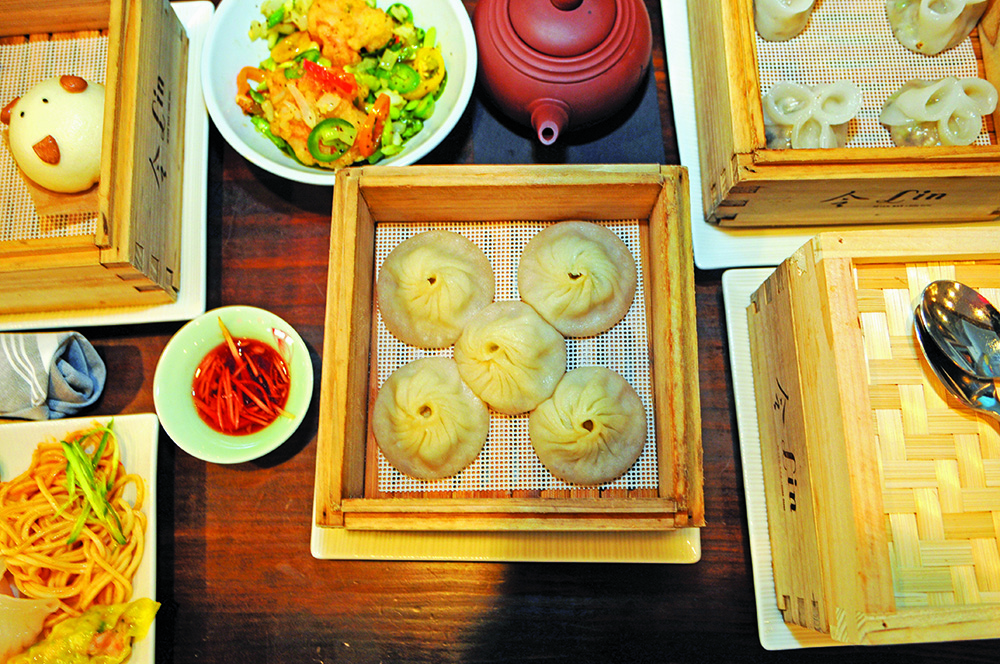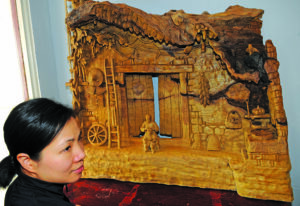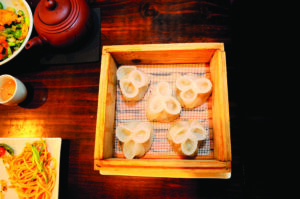 Open only since June of 2018, Lin Asian Bar on west 6th street in Austin has garnered so much positive buzz that the wait for Dim Sum on Saturday mornings regularly looks like the line for an amusement park roller coaster. Adding to the draw is the fact that the food and experience make the wait completely worth it.
Open only since June of 2018, Lin Asian Bar on west 6th street in Austin has garnered so much positive buzz that the wait for Dim Sum on Saturday mornings regularly looks like the line for an amusement park roller coaster. Adding to the draw is the fact that the food and experience make the wait completely worth it.
Lin’s Chef and co-owner Wu Ling Qi has been cooking in Austin for a few decades; fifteen years at Chinatown on Graystone, then briefly at Chinatown on Bee Caves road, eventually becoming the ‘Wu’ in Wu Chow; but now along with husband Jimmy Ng, she is able to express her passion and skill the way she has always wanted.
I was lucky enough to spend a few hours with Chef Ling on a recent Saturday and became as much a fan of the lady as I was of her cooking.
A repeating theme in talking with Chef Ling is her love of learning; from cooking techniques, new spice combinations, playing with meat textures, to tweaking already good recipes for the best possible result. The Asian chef community in Austin she says is very interconnected with many having worked alongside each other at various restaurants for years. “We all have the same recipes”; however, at Lin, I believe how those recipes are executed and evolve make all the difference.
 Chef Ling is originally from Fujian Province in southeast China which has the reputation of being the most diverse when it comes to cooking styles. Fujian lies on the coast across from the Island of Taiwan. It is northeast of Hong Kong and the epicenter of Cantonese cooking (and Dim Sum), and southwest of Shanghai, known for its Hu style of cooking and famous for Xiaolongbao or ‘soup dumplings’ which are a featured item at Lin.
Chef Ling is originally from Fujian Province in southeast China which has the reputation of being the most diverse when it comes to cooking styles. Fujian lies on the coast across from the Island of Taiwan. It is northeast of Hong Kong and the epicenter of Cantonese cooking (and Dim Sum), and southwest of Shanghai, known for its Hu style of cooking and famous for Xiaolongbao or ‘soup dumplings’ which are a featured item at Lin.
Chef Ling uses techniques and recipes learned from her beloved grandmother Zi-Ying, along with Cantonese favorites learned over the years in restaurants and even tastes from Malaysian street food (husband Jimmy’s origins). She stresses that freshness and farm to market concepts have always been a part of good Chinese food though some unique, authentic ingredients could sometimes be hard to find. One welcomed change with Austin’s growth has been the ability to get a wider variety of Asian vegetables, mushrooms, and other ingredients more readily.
A strong part of Chef Ling’s philosophy is indeed the long tradition of Chinese dishes and their connection to health. She is proud of the many vegetable dishes she is now able to provide. Supporting all the good proteins and vegetables are the wonderful spices throughout Chef Ling’s dishes.
Traditional Chinese “five spice” (equal parts cinnamon, cloves, fennel seed, star anise, and Sichuan peppercorns) and “thirteen spice” (further adding ginger, nutmeg, tangerine peel, black peppercorns, sesame, chili, cardamom, and amomum fruit) are common in Chinese cuisine with many of these also having been used for centuries in traditional Chinese medicine for their digestive, anti-inflammatory and even anti-microbial properties.
Dim Sum, the weekend speciality at Lin, is essentially Cantonese brunch – an early meal, always incorporating hot tea and a variety of small bite-sized portions of food. Most items are served in small, stackable bamboo steamer baskets or on small plates. Ever important are fresh pots of hot tea. As Fujian Provence is famous for Jasmin scented tea – it is represented well at Lin.
 Featuring one of the first open (Chinese) kitchens in Austin, Lin’s kitchen is the primary feature of the modest-sized house on west 6th street. A mad buzz of activity supports the preparation of hundreds of steamer boxes and their delivery to the tables. Similarly, other restaurants could take this as an example and serve dumplings or similar steamed items in such cute steamer boxes that they could purchase from a commercial kitchen item supplier (click here for more info).
Featuring one of the first open (Chinese) kitchens in Austin, Lin’s kitchen is the primary feature of the modest-sized house on west 6th street. A mad buzz of activity supports the preparation of hundreds of steamer boxes and their delivery to the tables. Similarly, other restaurants could take this as an example and serve dumplings or similar steamed items in such cute steamer boxes that they could purchase from a commercial kitchen item supplier (click here for more info).
Our meal started with a trio of Dou Sha Bao, steamed buns filled with red bean paste, decorated to look like three little pigs in a small basket. The wheat dough was tender with just a bit of pull, and the made-in-house red adzuki bean paste inside was savory and sweet at the same time.
Chef Ling explained that the traditional order of appetizer, entrée, and dessert is not as strict in Chinese meals – comfortably allowing for “eat dessert first” types.
Next, Chef sent out a bowl of Dan Dan noodles. These were spaghetti-like noodles in a bowl of peanut sauce and chilies with a chiffonade of scallion. It was light and very flavorful with a nice balance of spicy and savory.
What followed was like Christmas morning, with box after box of wonderful surprises. In addition to outstanding Salt and Pepper (fried) Shrimp and Pan-fried Beef Buns on little plates, we got beautiful boxes of Shrimp Har Gow, traditional pork and Shrimp Siu Mai, and less common, but delicious chicken, cashew and mushroom dumplings.
Interestingly the dough for the Har Gow is made from a combination of wheat and tapioca starches making them a little translucent and slightly chewy. The quality of the shrimp is supreme in this dish as it is by far the bulk of the filling.
The more familiar Siu Mai are crinkly yellow wonton wrapper cups filled with ground pork, chopped shrimp, Chinese black mushroom, green onion. The unusual “three-eye” shape of the chicken and cashew dumplings was new to me and is one of several different visual treatments Chef Ling makes herself.
For something a little farther afield for non-Chinese diners, Chef invited us to try braised chicken feet. They were a little shocking in their straight forward presentation, but the very tender texture and complex five spice seasoning allowed us to enjoy them equally as the many tables around us.
Next came something that Chef Ling has helped put on the map in Austin; Xiaolongbao or ‘soup dumplings,’ are small tangerine sized balls of wheat dough filled with a delicate broth and seasoned pork. Served with just a bit of black vinegar and fresh slivered ginger on the side, these have become a must have item at the restaurant. The trick Chef Ling manages to pull-off is keeping the dough very thin and tender allowing the rich broth and flavorful pork to shine underneath. Word to the wise – the broth is very hot when the dumplings come to the table, a little time and patience will prevent a painful soup accident.
Chef followed the standard soup dumpling with a single ‘Shanghai’ Jumbo Seafood Soup Dumpling. Baseball-sized, and filled with broth, shrimp, and lobster, it was virtually a meal on its own.
 As we wound down our visit, sure that we would not be able to eat a single bite more, three beautiful desserts arrived at the table. Chef Ling sent out a honeycomb cheesecake which was light and far less sweet than expected, a plate with a tiny bear and block made from passion fruit mousse which was almost too pretty to eat, and a small art piece of nested, dark chocolate and tea scented chocolate balls echoing the complex jade sculptures.
As we wound down our visit, sure that we would not be able to eat a single bite more, three beautiful desserts arrived at the table. Chef Ling sent out a honeycomb cheesecake which was light and far less sweet than expected, a plate with a tiny bear and block made from passion fruit mousse which was almost too pretty to eat, and a small art piece of nested, dark chocolate and tea scented chocolate balls echoing the complex jade sculptures.
Following tradition, our entire meal was accompanied by some of the most delicately flavored jasmine tea I have ever had.
Lin offers Lunch weekdays and a very lush Dinner menu including many dishes incorporating Angus Beef, tender Pork shanks, steamed whole fish, duck, and beautifully spiced lobster dishes along with a smaller variety of Dim Sum items.
A full (and busy) bar allows waiting patrons to enjoy themselves before dinner and thanks to Jimmy a hundred and fifty label (mostly California) wine menu allows for some very nice pairings for those wanting something stronger than hot tea.
Though the space is modest in size, a few design features are too good not to mention. What appears to be framed paintings on several of the walls are in fact made of silk embroidery on an extraordinary scale. Some items, like a colorful standing Buddha, appear photorealistic until seen very close up.
To me, the large wood sculpture at the entrance of the restaurant representing a young Ling and her grandmother at their home (a gift from Jimmy), is one of the most touching pieces of art. Chef fondly points out the details of the fire burning stove ‘that used an actual bellows,’ the baskets, brooms, and woven armor all executed in beautiful detail.
When I first started going to dim sum for brunch decades ago, I made the mistake of usually being in a small party, ordering quickly and finishing the same way.
Chef Ling helped me understand that Dim Sum is best done as a family or larger group of friends and should be enjoyed at a slower pace…. over some very nice hot tea.
By Richard Arebalo
Features Editor